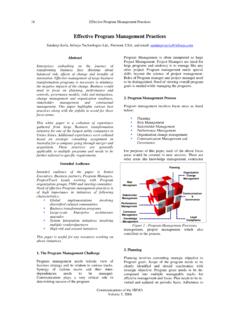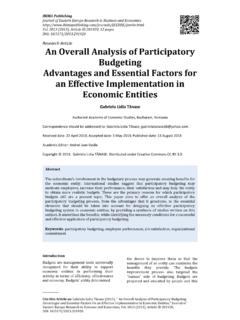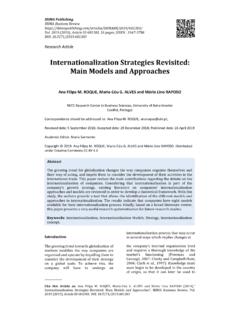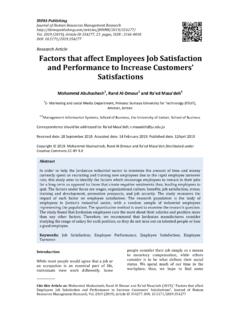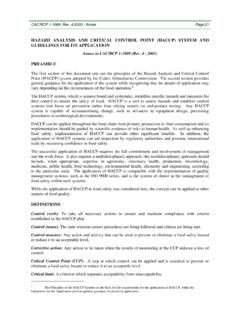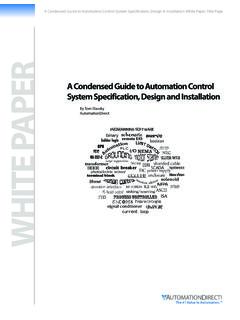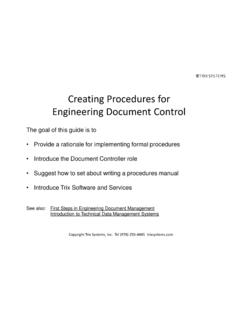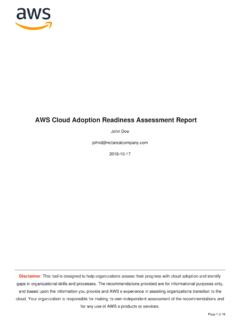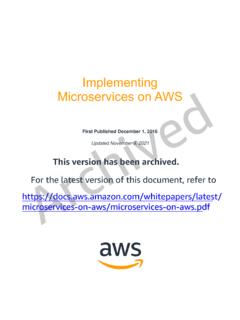Transcription of A Work Breakdown Structure for Implementing and Costing …
1 A Work Breakdown Structure for Implementing and Costing an ERP Project Communications of the IBIMA Volume 6, 2008 94 A Work Breakdown Structure for Implementing and Costing an ERP Project Aisha Momoh, Decision Engineering Centre, Cranfield University, Bedford, Rajkumar Roy, Decision Engineering Centre, Cranfield University, Bedford, UK, Essam Shehab, Decision Engineering Centre, Cranfield University, Bedford, Abstract This paper presents a Work Breakdown Structure (WBS) for a phased implementation of an Enterprise Resource Planning (ERP) solution. The key activities that constitute an ERP implementation project are discerned in detail, each in its entirety. Each activity illustrates the tasks required to fulfill each part of a project. The potential challenges that are usually encountered in every selected activity are discussed. Finally, using a WBS to cost an ERP project is proposed.
2 Keywords: Work Breakdown Structure ; WBS; ERP; Project Activities 1. Introduction ERP has been referred to as a business operating system that enables better resource planning and improved delivery of value-added products and services to customers [10]. They automate core corporate activities such as manufacturing and the management of financial, and human resources and the supply chain [10]. Major business drivers behind ERP implementations are: improving productivity, providing competitive advantage, and satisfying customer demands [5]. Although ERP applications have been widely adopted by a variety of industries worldwide, the challenges faced during and post-implementation remain a growing concern. ERP systems are complex pieces of software [5]. Consequently, many such implementations have been difficult, lengthy and over budget, were terminated before completion, and failed to achieve their business objectives even a year after implementation [5].
3 Researchers and practitioners alike are still in the process of studying and understanding the causes of these hurdles. As part of this research, an in-depth literature review highlighted numerous project challenges. Based on the Risk Factors of ERP, one of the risks identified in project management and control , is a lack of effective project management methodology [4]. However, very little is mentioned about ERP project planning methodologies in research. Based on the primary author s in-depth experience in ERP implementations, predominantly SAP, she recognizes that some project methodologies are not detailed enough. Regardless of how effective a methodology may appear, should it lack the relevant detail, the project in question may not yield the anticipated success. In order to achieve a successful implementation, this paper proposes the use of a work Breakdown Structure (WBS) to guide an ERP project.
4 A Work Breakdown Structure is a project management tool. It is defined as an enumeration of all work activities in hierarchic refinement of detail which organizes work to be done into short manageable tasks with quantifiable inputs, outputs, schedules, and assigned responsibilities [14]. A WBS is also used for project Costing . This paper discusses using a WBS to organize an ERP project, Literature review reveals that ERP implementations are fraught with numerous problems. ERP implementations are notorious for taking a longer time and taking more money than is projected [12]. Most of the literature studied indicates a variety of issues inherent in executing an ERP project. However, there is hardly any mention of failures based on poor project planning and methodology. Based on in-depth ERP experience and use of various project methodologies, the primary author recognizes that several projects fail as a consequence of poor planning.
5 This area requires significant attention. 2. Research Methodology The methodology that was employed in this research was based on the following: Information gathered on company-specific project methodologies, ERP implementations, Accelerated SAP (ASAP) project methodology used in SAP R/3 projects and Work Breakdown Structures based on primary author s ERP project experience. Literature review on ASAP Aisha Momoh,Rajkumar Roy and Essam Shehab Communications of the IBIMA Volume 6, 2008 95 Identifying project activities that are excluded from ASAP based on knowledge of company-specific project methodologies. Using a WBS to amalgamate the identified project activities with the ASAP project activities Based on literature review of ERP challenges and previous case study, identifying challenges associated with each project activity in the WBS. 3. ASAP Project Methodology SAP introduced the ASAP implementation methodology with the goal of speeding up SAP implementation projects [9].
6 ASAP implementation is a structured implementation approach that can help managers achieve a faster implementation with quicker user acceptance, well-defined roadmaps, and efficient documentation at various phases [9]. The ASAP methodology phases are [9]: Project preparation the purpose of this phase is to provide initial planning and preparation of the SAP project. The steps of this phase help identify and plan the primary focus areas to be considered such as: objectives, scope, plan and definition of project team. The outcome is the project charter. Business blueprint the purpose of this phase is to create the business blueprint, which is a detailed documentation of the organizational Structure and business processes gathered during requirements workshops/meetings. It will allow the implementation project team to clearly define their scope, and only focus on the SAP processes needed to run the organization business.
7 Realisation the purpose of this phase is to actually configure SAP R/3 based on the specifications of the business blueprint as well as taking further input into account (Questions and Answer database). The objective is the final configuration of the system , an overall test, and the release of the system for live operation. Final preparation the purpose of this phase is to complete the final preparation, including testing, end user training, system management and cutover activities. The final preparation phase also serves to resolve all open issues. Go live and support the purpose of this phase is to move from a pre-production environment to live operation. A support organization must be set up for end users to provide long-term support. This phase is also used to monitor system transactions and to improve overall system performance. Finally, the completed project is closed.
8 Each phase is composed of a group of work packages [9]. These work packages are structured in activities, and each activity is composed of a group of tasks [9]. For each task, a definition, a set of procedures, results and roles are provided in the ASAP methodology documentation [9]. Implementations where ASAP or Powered by SAP methodologies were used averaged only 8 months, compared to 15 months for standard implementations [9]. 4. Work Breakdown Structure for ERP Implementation A complex project is made manageable by first breaking it into individual components in a hierarchical Structure , known as Work Breakdown Structure [13]. Such a Structure defines tasks that can be completed independently of other tasks, facilitating resource allocation, assignment of responsibilities, and measurement and control of the project [13]. This section depicts the use of a WBS in Figures 1, 1a and 1b to plan an ERP project.
9 The various levels in the WBS are illustrated in Table 1. A Work Breakdown Structure for Implementing and Costing an ERP Project Communications of the IBIMA Volume 6, 2008 96 Fig 1. WBS for ERP Implementation Aisha Momoh,Rajkumar Roy and Essam Shehab Communications of the IBIMA Volume 6, 2008 97 Fig 1a. WBS for ERP Implementation A Work Breakdown Structure for Implementing and Costing an ERP Project Communications of the IBIMA Volume 6, 2008 98 Fig 1b. WBS for ERP Implementation Table 1 below illustrates the various levels of project activity in the WBS structures above. Each organization uses its own terminology for classifying WBS components according to their level in the hierarchy [13]. For example, some organizations refer to different levels as tasks, sub-tasks and work packages, whilst others use the terms phases, entries and activities [13]. In this paper, activities are used to classify the WBS components.
10 The nodes (in circles) A and B indicate continuation of the activities linked to these nodes Table 1: WBS Component Levels Project First Level Activity Second Level Activity Third Level Activity ERP Implementation Project Preparation Define Project Scope and Objectives Identify Project Team Identify Stakeholders system Architecture Design Identify system Environment Technical Infrastructure Preparation Identify Development Environment Identify Quality Assurance Environment Identify Training Environment Identify Production Environment Business Blueprint AS-IS Business Process Analysis Identify End-to-End Current Business Processes Identify Process Integration Points Map ERP Processes to Business Processes Aisha Momoh,Rajkumar Roy and Essam Shehab Communications of the IBIMA Volume 6, 2008 99 Project First Level Activity Second Level Activity Third Level Activity Define TO-BE Processes Define End-to-End Future Business Processes Identify Gaps Propose Gap Solution Define Reports Define Programs Define Interfaces Define Manual Processes Document Blueprint Sign Off Blueprint Configuration and Development Configure Solution Write Unit Test Scripts Configure Solution Unit test Configuration Develop Code for Identified Gaps Write Technical Specifications Write Unit Test Scripts Unit Test Programs/Reports/Interfaces Sign Off Configuration and Development Define Authorizations Define Roles in Organisation Identify Roles for Use of ERP Define Authorisations Test Authorisations Sign Off Authorisations Data Conversion Define Fields in ERP Solution Map ERP Fields to Legacy system Fields Convert Legacy Fields to ERP Fields Define Data for Cleansing Cleanse Data Sign Off Data
